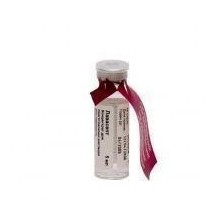



LAVACEPT - antiseptic drug.
Polyhexanide has a broad spectrum of antimicrobial action.
Active in relation to:
Gram-positive and gram-negative bacteria (including Pseudomonas aeruginosa).
Mushrooms.
Polyethylene glycol (PEG) reduces surface tension, which contributes to enhancing the action of polyhexanide.
In the presence of protein (0.2% albumin), the effect of the drug is weakened only slightly, and when conducting quantitative tests a good fungicidal and bactericidal effect is detected.
The drug does not contain substances that have an irritating effect: halogen and mercury-containing antiseptics, iodine, heavy metals, polyvinylpyrrolidone and aldehydes.
Polyhexanide is chemically stable, non-volatile, odorless, soluble in water, ethanol, glycerol, propylene glycol and other solvents.
Polyhexanide has a low toxicity, and the content of polyethylene glycol in Lavasept concentrate is low in order to enhance the toxicity of polyhexanide.
- antiseptic treatment in the surgical treatment of infected wounds and superficial soft tissue injuries;
- washing the cavities through the drainage tubes using active drainage;
- irrigation of the operative field during surgery during reconstructive operations, immediately prior to bone and soft tissue transplantation;
—The irrigation of the operational field during operations with the existing threat of infection;
—The treatment of infected wounds during the operation of a hip joint endoprosthesis (according to Schneider);
- Antiseptic protection of open wounds;
- treatment of burn surfaces;
—Antiseptic treatment during maxillofacial operations;
—Processing of surgical instruments, dressings and patient care items.
Polyhexanide
Excipients: water d / i, macrogol 400 (PEG) 10 mg
No customer reviews for the moment.
Lavasept concentrate is used only externally. Before applying Laveapept concentrate should be diluted to a concentration of 0.1% or 0.2%.
For washing and drainage of wounds, a 0.1% solution of Lavasept concentrate should be used.
In the case of infection of the wounds with gram-negative flora, a 0.2% solution of the drug is used.
Rules of preparation of the solution
To prepare a 0.1% or 0.2% Lava-cept solution, 1000 ml of Ringer’s solution should be added with 1 ml or 2 ml of Lava-cept concentrate, respectively. When mixed with other solutions, turbidity and precipitation should be avoided. Polyhexanide precipitated at low temperatures can be dissolved by heating the solution to 60 ° C.
Allergic reactions: skin rash, urticaria.
- operations on uninfected joints;
- brain and spinal cord surgery (neurosurgical operations);
- operations on the middle and inner ear;
- eye operations (ophthalmologic operations);
- intraperitoneal washing;
- increased sensitivity to the components of the drug.
Currently, cases of drug interactions are not known.
Currently, there is not enough data on the use of Laveasept concentrate during pregnancy and lactation. It is not recommended to use the drug in the first trimester of pregnancy. In later periods of pregnancy and lactation, use is possible only if the intended benefit to the mother exceeds the possible risk to the fetus or child.
Cases of overdose are not described.